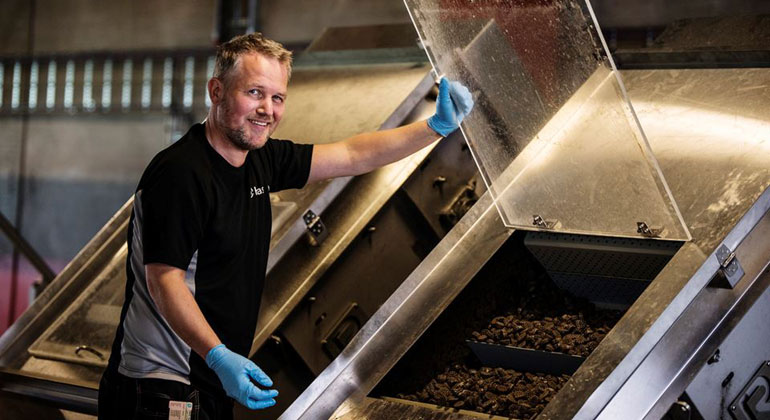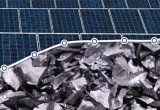Recovering eco-friendly phosphorous from wastewater
A shortage of phosphorous is driving the price of artificial fertilisers through the roof. But a new and eco-friendly wastewater decontamination process has enabled a company in Hamar in Norway to kill two birds with one stone.
For many decades now, researchers have been warning that a shortage of phosphorous may have a catastrophic impact on global food production, and the EU has included this essential mineral on its list of Critical Raw Materials.
This has encouraged staff at the inter-municipal wastewater plant HIAS IKS outside Hamar to start thinking outside the box. Researchers and engineers at the plant have been developing a process that removes phosphorous from wastewater without the use of chemicals, enabling it to be recycled as fertiliser. The company is now hoping that others in the sector will be encouraged to use this innovative approach.
HIAS IKS is participating in an EU project called Wider Uptake, which is being coordinated by SINTEF. The aim of Wider Uptake is to identify how best to exploit available water resources, limit negative emissions and discharges, and develop sustainable business models within the water management sector.
“Wider Uptake is all about identifying so-called ‘water smart solutions’ by which we exploit the value both of and in the water in an attempt to develop circular economic solutions”, says Herman Helness, who is both a researcher at SINTEF and Project Coordinator.
In addition to HIAS IKS, the Stavanger company IVAR IKS is participating in the project as a ‘demonstration case’, together with companies from Italy, the Czech Republic, the Netherlands and Ghana.
Not the traditional route
Ten years ago, when HIAS IKS was planning to renovate its run-down and overloaded facility, it chose to ignore the advice it was given about future proofing.
“We received all the standard recommendations about best practice and the future of the facility, but we also carried out a risk assessment and discovered that these measures didn’t meet our needs”, says Morten Finborud, who is General Manager at HIAS IKS.
“After conducting some research, combined with more work and development, we decided that a biological approach to phosphorous removal would be at least as effective, enabling us to continue normal operations without the use of chemicals”, he says.
The method developed by the company has been patented and given the name ’the HIAS process’. According to Finborud, it is simpler, less expensive, and more eco-friendly than traditional chemical removal.
What exactly is the HIAS process?
“Traditionally, chemicals have been used to bind the phosphorous in the sewage and remove it to the waste sludge”, explains Helness. “But at HIAS they’re using a biological process that employs bacteria to ‘eat’ the phosphorous and remove it to the sludge in a different way”, he says.
“Chemicals cause the phosphorous to become very strongly bound, making it difficult to remove it from the sludge”, says Helness “A biological process, on the other hand, such as that being used by HIAS, enables us to get the bacteria to release the phosphorous more easily for later recycling”, he says.
Helness says that there is nothing new about the biological removal of phosphorous. The innovation lies in the way in which the HIAS process is designed.
“The HIAS process is a so-called biofilm process”, he says. “The bacteria are fixed onto small fragments of plastic that enable the process to be more compact and easier to manage. The plastic fragments are embedded in the slots of a carousel as part of an efficient and effective technical system”, he says.
Eco-friendly and highly profitable
HIAS IKS has now completely rebuilt its wastewater facility to accommodate the HIAS process, and will, later this year, start to recycle the recovered phosphorous. The phosphorous is recovered in the form of a substance called struvite, which can be used in organic agriculture.
“Among other things, struvite has been approved as an organic fertiliser”, says Morten Finborud. “Given the current status of the global fertiliser market, interest in struvite is very much on the up and we expect to start production during the summer”, he says.
The price of artificial fertilisers has risen dramatically in recent months, primarily due to the high price of natural gas.
Finborud believes that it is hard to find any disadvantages in investing in the biological removal of phosphorous from wastewater.
“The main benefit is a significant 40 to 50 percent saving in operations costs, combined with an opportunity to recover the phosphorous as a resource”, he says. “Once you have a less expensive and more eco-friendly process in place, there are few arguments left to prevent you from using it. But ours is a very conservative sector”, says Finborud.
Time to be thinking outside the box
Anders Øfsti is General Manager at HIAS HOW2O, the commercial sister company to HIAS IKS that is working to market and promote the sale of the HIAS process to other wastewater facilities. He fully agrees with Finborud’s description of current attitudes in the sector.
“We’re fighting against rampant conservatism”, says Øfsti. “It isn’t easy persuading people to be comfortable with a new technology that will turn their world upside down”, he says.
Øfsti says that enormous levels of investment are required in Norwegian wastewater infrastructure during the next five to six years in order to meet new requirements stipulated by the authorities.
“The entire sector is more or less in a state of panic, simply because so much new building has to be done in such a short time”, he says. “But persuasion is a difficult task, because companies tend to stick with what they feel safe with. In this case, methods that have been shown to work for 30 years. It isn’t as though the chemical approach doesn’t work. But operational costs are high, and it isn’t very sustainable. The use of chemicals leaves a big climate footprint, and you don’t get the benefit of recovering the phosphorous”, says Øfsti.
Phosphorous recovery can resolve the crisis
In a report published in 2015, the Norwegian Environment Agency claims that there is major potential for the more effective exploitation of the phosphorous currently in circulation in Norway. The HIAS process was one of the innovations highlighted in the report.
“We believe that we’re helping to make the world a little greener and reduce the costs accruing to the industry, simply in the first instance by implementing a process designed to meet our own needs”, says Finborud at HIAS IKS. We also believe that we’ve accumulated sufficient valuable expertise and experience to enable us to establish links with academic institutions and make a few more strides towards advancing the process”, he says.
“We also believe that we have a method that is entirely different to any other in terms of addressing future needs”, he continues. “We recognise that sustainability and circular economic ideas are the way to go. We simply have to steel ourselves and grasp the nettle”, says Finborud.








